2025 GWM Haval H6 GT PHEV Review: A Game-Changing Plug-In Hybrid SUV for Australia
By CarSauce Team | Published April 22, 2025
The 2025 GWM Haval H6 GT PHEV has arrived in Australia, shaking up the plug-in hybrid SUV segment with its bold design, potent performance, and competitive pricing. Priced at approximately $53,990 (₹40 lakh–₹50 lakh), it undercuts rivals like the BYD Sealion 6 and Toyota RAV4 Hybrid while offering a claimed 180 km electric-only range and blistering acceleration. But does this swoopy, aviation-inspired SUV live up to its promise? After a week of testing, including a memorable roadside assist adventure, we’ve put the Haval H6 GT PHEV through its paces to help Australian buyers decide if it’s the right choice. From its exterior flair to its tech-laden interior, driving dynamics, and practicality, here’s our in-depth review.
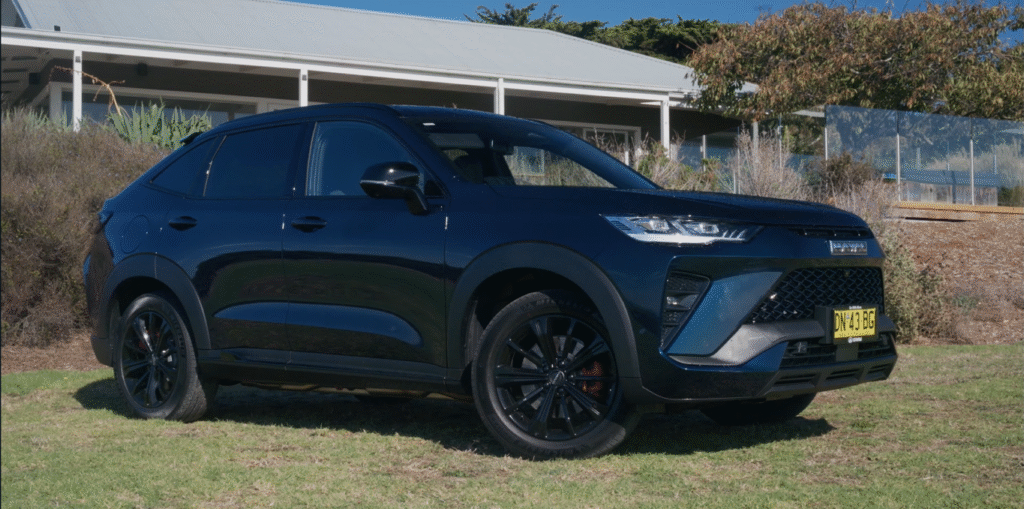
Haval H6 GT PHEV Specs at a Glance
- Price: $53,990 (₹40 lakh–₹50 lakh (ex-showroom, estimated))
- Powertrain: 1.5L turbo petrol + 2 electric motors (321 kW, 762 Nm)
- Battery: 35 kWh NMC
- Electric Range: 180 km (claimed), ~140 km (real-world)
- Fuel Efficiency: 5.2 L/100 km (hybrid mode)
- 0–100 km/h: 4.89 seconds
- Boot Space: 392 L (expandable to 1290 L)
- Safety: Full suite (adaptive cruise, lane centering, 360° camera)
- Charging: 40 kW DC, 6.6 kW AC, 3.3 kW vehicle-to-load
- Warranty: 7 years/unlimited km (expected, per GWM Australia)
- Tyres: Michelin Primacy 4 (215/55 R19)
Exterior: Bold, Sporty, and Aviation-Inspired
The Haval H6 GT PHEV’s coupe-SUV design screams aggression, with a lowered stance and aviation-inspired styling that sets it apart in cities like Mumbai or Delhi. Its LED headlights are bright and sleek, paired with unique daytime running lights and sequential turn signals that add flair. The large grille with the prominent “Haval” badge exudes confidence, though the faux aero elements (e.g., fake vents and carbon-fiber accents) might feel excessive for some. A facelifted rear for late 2024 introduces tinted taillights and a ducktail spoiler, enhancing its sporty appeal.
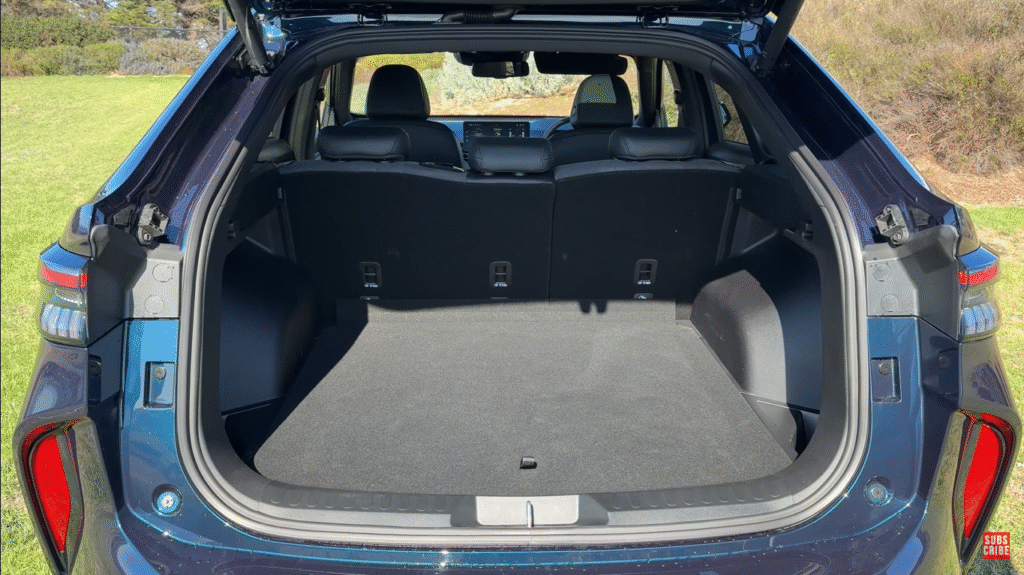
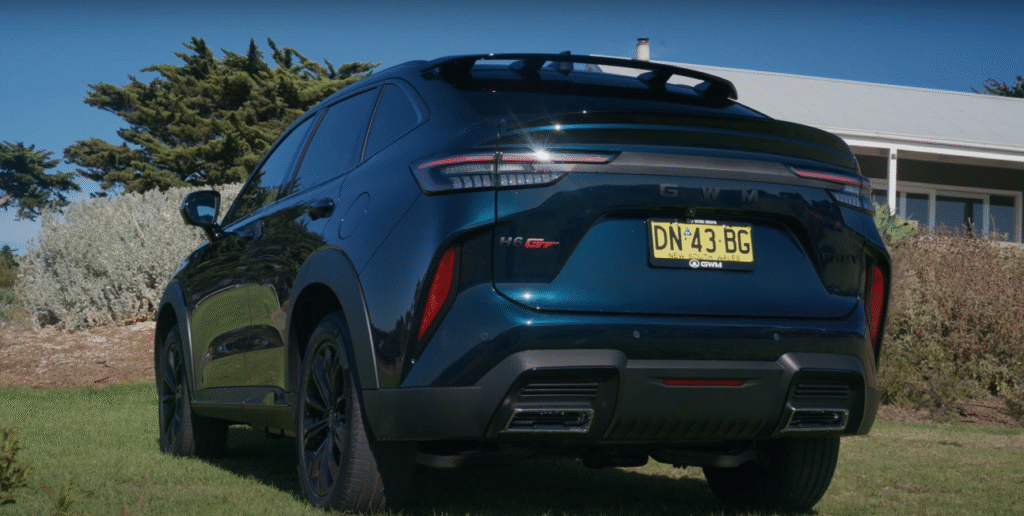

The side profile features 19-inch black alloy wheels with red brake calipers, wrapped in Michelin Primacy 4 tires for decent grip. Black mirror caps, privacy glass, and roof rails complete the look, while the AC/DC charging port (up to 40 kW DC) is neatly integrated. However, charging speeds disappointed in our test, peaking at 21 kW on a 50 kW charger—a drawback for buyers relying on Australia’s growing fast-charging network (e.g., Tata Power stations). The fuel filler cap accepts 91-octane petrol, keeping running costs low.
Drawbacks: The faux diffuser and exhausts feel gimmicky, and the naming (GWM, Haval, Tank) can confuse buyers. GWM should streamline its branding for clarity in Australia.
Interior: Premium but Needs Refinement
Step inside, and the H6 GT PHEV’s interior feels premium yet quirky. Soft-touch materials, faux carbon fiber, and Alcantara-like suede (possibly real) create a plush ambiance, rivaling the BYD Sealion 6’s cabin. The 12.3-inch touchscreen is snappy but has quirks, like lagging randomly or requiring extra presses to adjust air conditioning. Wired Apple CarPlay and Android Auto work well, but the cable placement (passenger side) is inconvenient for drivers in Bengaluru’s traffic. The digital instrument cluster displays useful data, though odd translations like “cum consumption” (cumulative consumption) could use polishing.
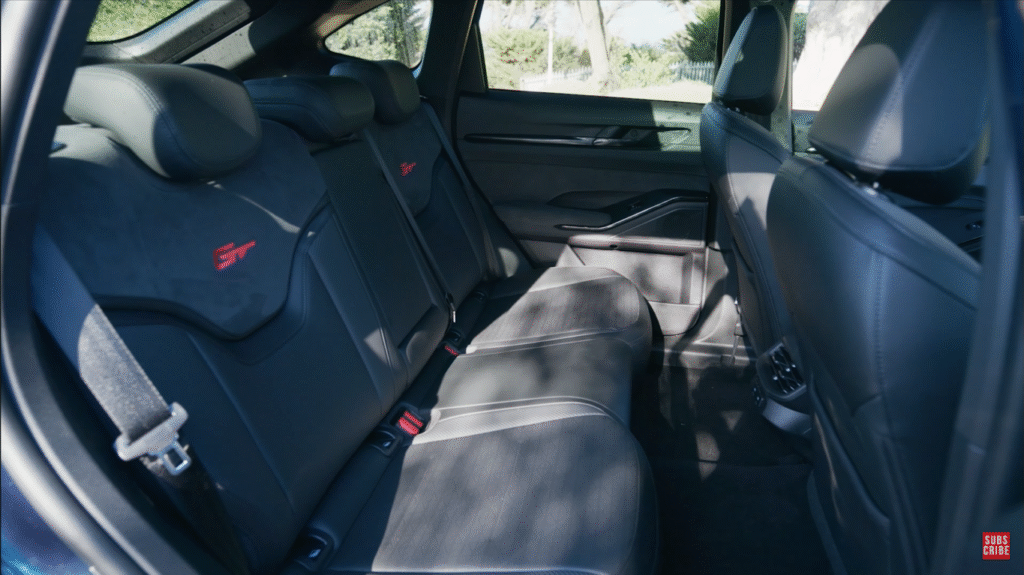

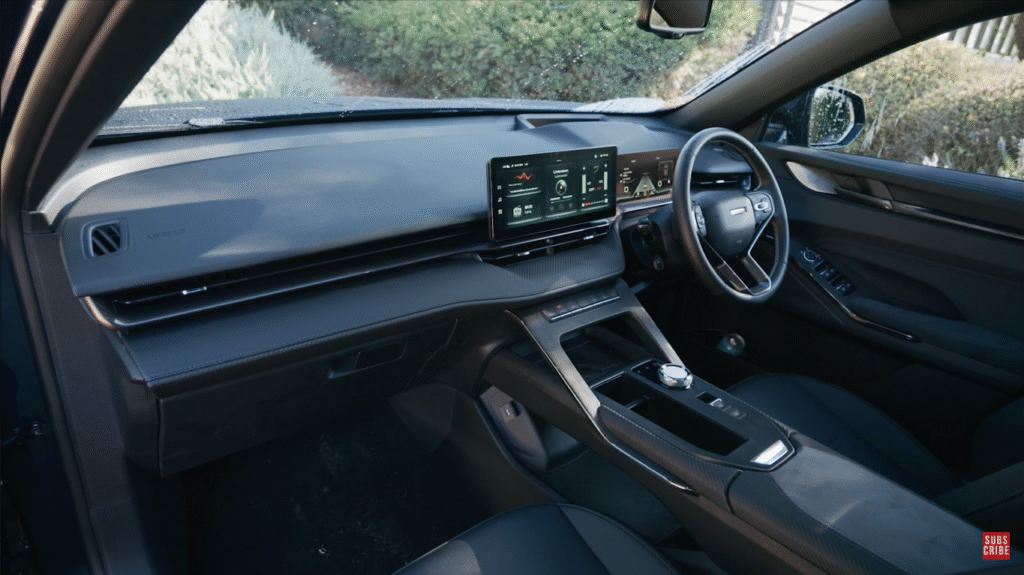
The front seats, with their GT badge and Alcantara trim, look sporty but lack under-thigh support, a letdown for taller drivers (e.g., 5’11”). Lumbar support helps, but comfort trails the rear seats. The steering wheel, with white stitching and a thin rim, feels odd due to its uneven reach—too far at the top, too close at the bottom. Storage is a highlight: a wireless charger, pop-out cup holders, a deep center console, and large door bins make it practical for families in Chennai or Pune.
The rear seats are a revelation, offering ample legroom, headroom, and under-thigh support despite the sloping roofline. Features like USB-A ports, air vents, and a soft armrest with cup holders enhance comfort on long drives to Goa. However, scratchy plastics in some areas and a subpar sound system (overly processed audio) detract from the experience. A massive panoramic sunroof (openable) and heated seats/steering wheel add luxury, though cooled seats are missed at this price.
Drawbacks: The air conditioning blows lukewarm air, and the touchscreen’s quirks (e.g., disabling auto AC randomly) need refinement. The sound system and front seat comfort lag behind competitors like the Toyota RAV4 Hybrid.
Performance: A Thrilling Powerhouse
The Haval H6 GT PHEV’s 1.5L turbo petrol engine and dual electric motors deliver a staggering 321 kW and 762 Nm, making it one of the most powerful SUVs under ₹50 lakh. Our test clocked 0–100 km/h in 4.89 seconds, beating GWM’s 4.9-second claim—a party trick that outpaces the BYD Sealion 6. The launch control engages with stability control off, delivering neck-snapping acceleration perfect for overtaking on the Delhi-Mumbai Expressway.

The 35 kWh NMC battery enables a 140 km real-world electric range, ideal for daily commutes in Hyderabad without using petrol. Modes like EV Only, EV Priority, and Intelligent Hybrid let you tailor performance. In hybrid mode, it achieves 5.2 L/100 km, competitive with the Toyota RAV4 Hybrid. Regenerative braking feels inconsistent, impacting brake pedal feel, but the two-speed transmission ensures smooth power delivery.
On the road, the suspension is firm but manageable, soaking up potholes better than the petrol H6 GT. The low-mounted battery lowers the center of gravity, improving handling on twisty roads like those in the Western Ghats. Drive modes (Normal, Eco, Sport, Snow, Mud, Sand) and adjustable steering modes add versatility, though the brakes lack the bite expected for its power (Brembo brakes, available in some markets, would help). We even hit 60 km/h in reverse in a quirky test—another party trick!
Drawbacks: The adaptive cruise control keeps excessive distance from the car ahead, and lane centering occasionally misreads hand input, slowing the vehicle unnecessarily.
Practicality: Decent but Not Class-Leading
The H6 GT PHEV’s 392 L boot is modest for a midsize SUV, fitting a few suitcases but trailing the BYD Sealion 6’s capacity. Folding the rear seats expands space to 1290 L, suitable for trips to Rishikesh. However, the tire repair kit (no spare wheel due to the battery) is a letdown for Australia’s unpredictable roads. The 3.3 kW vehicle-to-load feature powers devices like laptops, handy for camping in Coorg.
Interior storage shines, with ample bins and a spacious glovebox. The full safety suite—including adaptive cruise, lane centering, 360° camera, and radar-based aids—ensures peace of mind in chaotic Delhi traffic, though calibration could improve. The 7-year warranty and 7-year roadside assist (tested during our lockout mishap!) add value, but buyers must note that window damage isn’t covered.
Drawbacks: Boot space and the lack of a spare wheel limit practicality. The sound system and air conditioning underperform for a ₹40 lakh SUV.
Value and Comparisons
At ₹40 lakh–₹50 lakh, the Haval H6 GT PHEV offers exceptional value, undercutting the BYD Sealion 6 (₹45 lakh+) and Toyota RAV4 Hybrid (₹50 lakh+). Its 180 km claimed range, 4.89-second sprint, and loaded features (panoramic sunroof, heads-up display) make it a compelling alternative. Compared to the BYD Sealion 6, the H6 GT PHEV drives better with a more potent powertrain, though the BYD offers a softer ride and larger boot. The Toyota RAV4 Hybrid is more refined but less powerful and pricier.
Pros:
- Blistering performance (321 kW, 4.89s 0–100 km/h)
- Long electric range (~140 km real-world)
- Premium interior with Alcantara and sunroof
- Competitive pricing and 7-year warranty
- Full safety suite and versatile drive modes
Cons:
- Modest boot space (392 L)
- Quirky touchscreen and air conditioning
- Inconsistent brakes and safety aids
- No spare wheel, subpar sound system
Final Verdict: Should You Buy the GWM Haval H6 GT PHEV in Australia?
The 2025 GWM Haval H6 GT PHEV is a transformative plug-in hybrid SUV that delivers thrilling performance, impressive electric range, and premium features at a competitive price. Its 321 kW powertrain and 140 km EV range make it ideal for urban commutes in Bengaluru or long drives to Jaipur, while its sporty design turns heads. However, quirky tech, modest boot space, and unrefined safety aids hold it back from perfection. For Australian buyers seeking a powerful, value-packed PHEV, the H6 GT PHEV outshines the BYD Sealion 6 in performance but needs refinement to match the Toyota RAV4 Hybrid’s polish.
Who Should Buy It?
- Performance enthusiasts wanting a fast, affordable PHEV.
- Urban buyers are prioritizing electric range for daily commutes.
- Families need a feature-rich SUV with decent rear-seat comfort.
Who Should Look Elsewhere?
- Buyers need maximum boot space or a spare wheel.
- Those prioritizing a refined interior and flawless tech.
It offers a claimed 180 km, with ~140 km real-world range, ideal for daily commutes.
It hits 0–100 km/h in 4.89 seconds, outperforming the BYD Sealion 6.
From $53,990 drive-away (until March 31, 2025), with a free 7kW charger.

